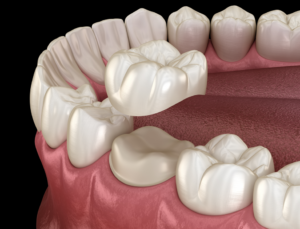
There are many reasons why you might need a dental crown; for example, you might have a tooth with a cavity so severe that it doesn’t just cause pain – it might also threaten your other teeth. Likewise, it’s also possible to suffer such drastic damage to a tooth that it cannot remain inside the mouth without some assistance. Regardless of why your dentist might suggest one, though, it’s helpful to understand how the placement of the crown will play out so you can adequately prepare yourself! Fortunately, it’s normally a streamlined and simple process. Here’s what you need to know.
The Dental Crown Placement Process
A dental crown is a cap that’s used to completely cover the chewing surface of a tooth, and they’re commonly used on the back teeth, or molars – though they can assist any tooth inside the mouth. They’re designed to look, feel, and function just like your original tooth, but to do this, they need to be custom-made and placed in a particular way. Here’s what this process looks like:
1. Damage Removal
The first step that a dentist takes in preparing a tooth for a crown is removing all the damaged or decayed tissues; they can’t remain there underneath the crown, after all! This is done only after the area of the mouth has been thoroughly numbed.
2. Deep Cleaning
The removal of the damaged or decayed tissue results in very tiny open spaces within the tooth, which are susceptible to bacteria growth. It’s essential that they’re thoroughly cleaned out and disinfected; putting a crown over these bacteria would only give them a perfect environment for multiplying.
3. Filling & Smoothing
After the tooth has been cleaned out, the empty spots are filled with a special biocompatible dental material called gutta-percha, which helps block bacteria from entering the tooth and also helps it retain its shape. Special instruments are also used to shave and smooth out the shape of the tooth, to ensure a proper fit.
4. Receiving Your New Crown
Once all of this has been accomplished, the tooth is ready for its new crown! You’ll likely receive a temporary one while your custom-made, permanent one is being fabricated at a dental lab, which normally takes a couple of weeks. You’ll be advised to avoid eating anything too hard, crunchy, or chewy during this time, as to protect your temporary restoration. When it’s finally ready, you’ll return for a short appointment to have the temporary crown replaced with your permanent one.
As with any sort of dental restoration, receiving a dental crown involves multiple steps; however, each plays a crucial part in ensuring that your tooth is able to shine brightly and remain a healthy part of your smile for several years to come.
About the Practice
The talented team at Ornelas Family Dentistry has proudly served the dental needs of patients in the Crown Point, IN community for several years, offering a wide range of services including restorative solutions like dental crowns, among others. If you have any questions about the blog, or you’d like to set up an appointment for yourself or a loved one, please feel free to contact the practice online or by phone for more information. Telephone: (219) 663-2892.
